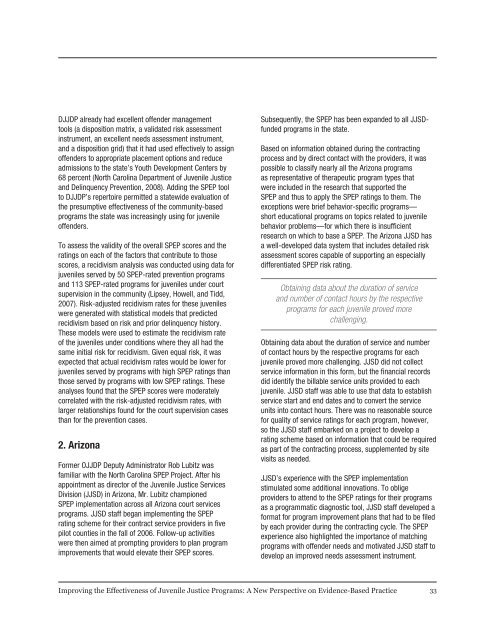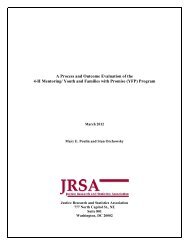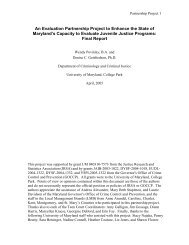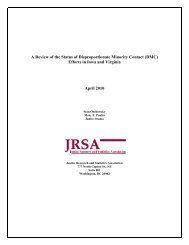Improving the Effectiveness of Juvenile Justice Programs: A New
Improving the Effectiveness of Juvenile Justice Programs: A New
Improving the Effectiveness of Juvenile Justice Programs: A New
Create successful ePaper yourself
Turn your PDF publications into a flip-book with our unique Google optimized e-Paper software.
DJJDP already had excellent <strong>of</strong>fender management<br />
tools (a disposition matrix, a validated risk assessment<br />
instrument, an excellent needs assessment instrument,<br />
and a disposition grid) that it had used effectively to assign<br />
<strong>of</strong>fenders to appropriate placement options and reduce<br />
admissions to <strong>the</strong> state’s Youth Development Centers by<br />
68 percent (North Carolina Department <strong>of</strong> <strong>Juvenile</strong> <strong>Justice</strong><br />
and Delinquency Prevention, 2008). Adding <strong>the</strong> SPEP tool<br />
to DJJDP’s repertoire permitted a statewide evaluation <strong>of</strong><br />
<strong>the</strong> presumptive effectiveness <strong>of</strong> <strong>the</strong> community-based<br />
programs <strong>the</strong> state was increasingly using for juvenile<br />
<strong>of</strong>fenders.<br />
To assess <strong>the</strong> validity <strong>of</strong> <strong>the</strong> overall SPEP scores and <strong>the</strong><br />
ratings on each <strong>of</strong> <strong>the</strong> factors that contribute to those<br />
scores, a recidivism analysis was conducted using data for<br />
juveniles served by 50 SPEP-rated prevention programs<br />
and 113 SPEP-rated programs for juveniles under court<br />
supervision in <strong>the</strong> community (Lipsey, Howell, and Tidd,<br />
2007). Risk-adjusted recidivism rates for <strong>the</strong>se juveniles<br />
were generated with statistical models that predicted<br />
recidivism based on risk and prior delinquency history.<br />
These models were used to estimate <strong>the</strong> recidivism rate<br />
<strong>of</strong> <strong>the</strong> juveniles under conditions where <strong>the</strong>y all had <strong>the</strong><br />
same initial risk for recidivism. Given equal risk, it was<br />
expected that actual recidivism rates would be lower for<br />
juveniles served by programs with high SPEP ratings than<br />
those served by programs with low SPEP ratings. These<br />
analyses found that <strong>the</strong> SPEP scores were moderately<br />
correlated with <strong>the</strong> risk-adjusted recidivism rates, with<br />
larger relationships found for <strong>the</strong> court supervision cases<br />
than for <strong>the</strong> prevention cases.<br />
2. Arizona<br />
Former OJJDP Deputy Administrator Rob Lubitz was<br />
familiar with <strong>the</strong> North Carolina SPEP Project. After his<br />
appointment as director <strong>of</strong> <strong>the</strong> <strong>Juvenile</strong> <strong>Justice</strong> Services<br />
Division (JJSD) in Arizona, Mr. Lubitz championed<br />
SPEP implementation across all Arizona court services<br />
programs. JJSD staff began implementing <strong>the</strong> SPEP<br />
rating scheme for <strong>the</strong>ir contract service providers in five<br />
pilot counties in <strong>the</strong> fall <strong>of</strong> 2006. Follow-up activities<br />
were <strong>the</strong>n aimed at prompting providers to plan program<br />
improvements that would elevate <strong>the</strong>ir SPEP scores.<br />
Subsequently, <strong>the</strong> SPEP has been expanded to all JJSDfunded<br />
programs in <strong>the</strong> state.<br />
Based on information obtained during <strong>the</strong> contracting<br />
process and by direct contact with <strong>the</strong> providers, it was<br />
possible to classify nearly all <strong>the</strong> Arizona programs<br />
as representative <strong>of</strong> <strong>the</strong>rapeutic program types that<br />
were included in <strong>the</strong> research that supported <strong>the</strong><br />
SPEP and thus to apply <strong>the</strong> SPEP ratings to <strong>the</strong>m. The<br />
exceptions were brief behavior-specific programs—<br />
short educational programs on topics related to juvenile<br />
behavior problems—for which <strong>the</strong>re is insufficient<br />
research on which to base a SPEP. The Arizona JJSD has<br />
a well-developed data system that includes detailed risk<br />
assessment scores capable <strong>of</strong> supporting an especially<br />
differentiated SPEP risk rating.<br />
Obtaining data about <strong>the</strong> duration <strong>of</strong> service<br />
and number <strong>of</strong> contact hours by <strong>the</strong> respective<br />
programs for each juvenile proved more<br />
challenging.<br />
Obtaining data about <strong>the</strong> duration <strong>of</strong> service and number<br />
<strong>of</strong> contact hours by <strong>the</strong> respective programs for each<br />
juvenile proved more challenging. JJSD did not collect<br />
service information in this form, but <strong>the</strong> financial records<br />
did identify <strong>the</strong> billable service units provided to each<br />
juvenile. JJSD staff was able to use that data to establish<br />
service start and end dates and to convert <strong>the</strong> service<br />
units into contact hours. There was no reasonable source<br />
for quality <strong>of</strong> service ratings for each program, however,<br />
so <strong>the</strong> JJSD staff embarked on a project to develop a<br />
rating scheme based on information that could be required<br />
as part <strong>of</strong> <strong>the</strong> contracting process, supplemented by site<br />
visits as needed.<br />
JJSD’s experience with <strong>the</strong> SPEP implementation<br />
stimulated some additional innovations. To oblige<br />
providers to attend to <strong>the</strong> SPEP ratings for <strong>the</strong>ir programs<br />
as a programmatic diagnostic tool, JJSD staff developed a<br />
format for program improvement plans that had to be filed<br />
by each provider during <strong>the</strong> contracting cycle. The SPEP<br />
experience also highlighted <strong>the</strong> importance <strong>of</strong> matching<br />
programs with <strong>of</strong>fender needs and motivated JJSD staff to<br />
develop an improved needs assessment instrument.<br />
<strong>Improving</strong> <strong>the</strong> <strong>Effectiveness</strong> <strong>of</strong> <strong>Juvenile</strong> <strong>Justice</strong> <strong>Programs</strong>: A <strong>New</strong> Perspective on Evidence-Based Practice<br />
33

















